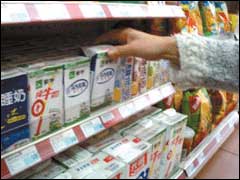| Tools: Save | Print | " target="_blank" class="style1">E-mail | Most Read |
| China to Boost Global Dairy Industry |
| Adjust font size: |
|
China hopes to boost the global dairy industry over the next 10 to 15 years, thanks to the growing consumption of milk and other dairy products in the world's most populous nation. With 1.3 billion people but only 13 percent of the world average milk consumption, China is very likely to help increase the global dairy output by expanding production to meet its own demands, said Wang Huaibao, vice director of China Association of Dairy Products Industry. China's dairy production has been posting double-digit growth annually since its reform and opening up in the late 1970s. It presently produces 16.25 million tons of dairy products a year, said Wang. The country also enjoys price advantages compared with many developed countries. In 2000, the most recent year that data is available, the cost per kilogram of fresh milk in China was 45 percent lower than what was reported in North America and the European Union, he said. But China's per capita consumption of dairy products is only 13 kilograms a year, much lower than the average 300 kilograms reported in the developed countries and the world average of 100 kilograms, according to Wang. "There's massive potential in the Chinese market," he said. With the sustained growth of China's economy and betterment of the people's life, Wang estimated China's per capita annual consumption of dairy products will increase to 18 kilograms by 2015. The country's dairy production, in the meantime, will grow at six to nine percent per year to top 25 million tons in 2015, he estimated. The world's milk production has seen sluggish growth between one to two percent over the past decade and the United Nation's Food and Agricultural Organization says the current production is around 594 million tons. The UN organization has attributed the industry's slowdown to restrictions on milk production from developed countries that together produce 71.7 percent of the world's dairy output. Meanwhile, sustained growth reported in the dairy industry in Asia, Latin America and Oceania is mostly offset by declining production in East Europe and the Commonwealth of Independent States, say analysts with the organization. They say Asia and Latin America, which have booming demands for dairy products, will continue to contribute to global milk production in the coming decade. But Wang warned domestic dairy producers to remain clear-headed and avoid hasty expansion in the current heated market. "We have to remember that many people in China are not yet ready to include milk in their diet," he said. "Most of the country's 9 million farmers never drink any because they don't like it or can't afford it." In large Chinese cities such as Beijing, Shanghai and Guangzhou, however, per capita annual consumption of fresh milk has reached 40 kilograms, which is already close to Asia's average consumption. "So there's little room for further growth in these cities," said Wang. On the other hand, lactose intolerance also discourages many Chinese from the dietary change. A recent survey shows that nearly 60 percent of the residents in Beijing cannot digest large amounts of lactose, the main sugar found in dairy products, and experience symptoms ranging from rashes to diarrhea and other digestive disorders, Wang said. He also urged domestic dairy companies to avoid "suicidal" price wars among themselves. "Such disorderly competition will benefit no one," he warned.
He said the situation became even worse in 2004, when less than25 percent of the domestic dairy producers made a profit. Wang said it is important for the dairy sector to map out an overall plan to promote development in a coordinated way. "Regulators from the industry itself, as well as industry and commerce authorities, should work together to step up with management and monitoring, standardize the order of competition and set market access threshold for dairy enterprises so as to prevent disordered competition," he said. The expert also encouraged domestic dairy makers to tailor more diverse products to different customers and minimize the use of antibiotics to improve the quality of their products. In 2004, researchers from Shanxi Agricultural University in north China's Shanxi Province dissevered a new drug made from dandelions to treat mastitis, a disease whose incidence rate is 30 percent on domestic dairy farms. The new medicine also reduces the cost for mastitis treatment from 23 yuan (US$2.8) to 9 yuan (US$1.08) per cow, said Professor Zhao Xiaoming with the university. (Xinhua News Agency February 9, 2005) |
| Tools: Save | Print | " target="_blank" class="style1">E-mail | Most Read |
 |
| Related Stories |
|

